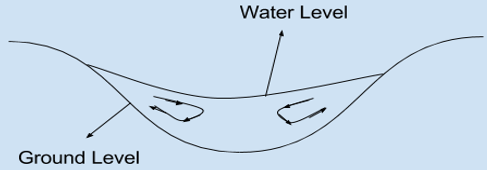This set of Irrigation Engineering Multiple Choice Questions & Answers (MCQs) focuses on “Behavior of Rivers”.
1. The numerous problems faced by the river is due to sediment carried by it.
a) False
b) True
View Answer
Explanation: The sediment which is being carried by the river poses numerous problems like the flood level gets increased, silting occurs in irrigation and navigation channels, meandering of rivers takes place, and the river gets splitted into number of channels.
2. Meandering of the river causes some serious problems.
a) True
b) False
View Answer
Explanation: Meandering of a river causes the river to change its original path and forces them to flow in new courses devastating vast areas of land and damaging nearby irrigation structures like dams, weirs, canals, and other structures like railway lines, and roads etc.
3. What is the shape of cross section of a straight reach?
a) Rectangular
b) Circular
c) Trough
d) Trapezoidal
View Answer
Explanation: The shape of cross section of a straight reach is in the shape of a trough, with high speed velocities of flow in the middle of the section.
4. What type of structure does the diagram represent?

a) Cut-Off
b) Meander
c) Bends
d) Straight Reach
View Answer
Explanation: The diagram shows a structure with cross section shape as a trough and the currents in the diagram shows transverse rotary currents, which in turn gives the information that the high velocity flow is in the middle of the section, and water level is high at the ends than at the middle. So, therefore according to this information interpreted the diagram represents a straight reach.
5. Which type of river tends to develop bends?
a) Alluvial River
b) Flashy River
c) Virgin River
d) Himalayan River
View Answer
Explanation: Alluvial River tends to form the bends as this type of rivers are always characterised by scouring on the concave side and silting on the convex side. And this scouring and silting action gets continued by the action of centrifugal force in the bend.
6. Where are shoals formed in a bend in a river?
a) Concave Side
b) Convex Side
c) Middle Section of the River
d) At the Bottom of the River Bed
View Answer
Explanation: Velocities at the bottom of the bend are much less than the velocities at the top, and enough centrifugal force is not present to counteract this tendency of water at the top. Due to this the water dives in from the top at the concave side and moves at the bottom towards the convex side. These rotary currents cause erosion at the concave side and deposition at the convex side, forming shoals on the convex side.
7. The complete formation of which curve leads to the formation of a meander?
a) Horizontal Curve
b) S-Curve
c) Vertical Curve
d) Circular Curve
View Answer
Explanation: When bend is developed in a river, the process moves downstream by the formation of shoals on the convex side with the help of secondary currents. The formation of shoals on the convex side leads further erosion on the concave side. So, therefore formation of successive bends of reverse order leads to complete formation of an s-curve called meander.
8. What is the name given to the straight reaches between two successive curves in a meander?
a) Cut-Off
b) Meander Belt
c) Crossings
d) Bend
View Answer
Explanation: The consecutive curves in a meander are connected with short straight reaches called crossings or in other words two consecutive clockwise and anti-clockwise loops in meander are connected with short straight reaches called crossings.
9. How many numbers of variables govern the meandering process?
a) 2
b) 3
c) 5
d) 4
View Answer
Explanation: Four variables govern the meandering process, namely silt grade and silt charge, discharge, bed and side materials and their action towards erosion, and valley slope. These all variables affect the meandering process, and all of them are interdependent.
10. What was the initial belief for the meandering process?
a) Velocity of the Flow
b) Excessive Bed Slope
c) Discharge
d) Type of Sediment Load Carried
View Answer
Explanation: The initial belief was that the meandering process is caused by the presence of excessive bed slope in the river that the excess energy is dissipated by increasing the channel length by meandering. But however, this belief was proved to be wrong.
Sanfoundry Global Education & Learning Series – Irrigation Engineering.
To practice all areas of Irrigation Engineering, here is complete set of 1000+ Multiple Choice Questions and Answers.
If you find a mistake in question / option / answer, kindly take a screenshot and email to [email protected]
- Practice Civil Engineering MCQs
- Practice Agricultural Engineering MCQs
- Check Irrigation Engineering Books
- Check Civil Engineering Books
- Check Agricultural Engineering Books
